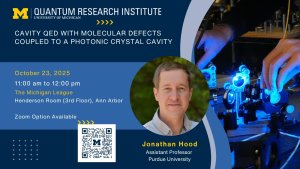Presented By: Quantum Research Institute
Quantum Research Institute | Cavity QED with molecular defects coupled to a photonic crystal cavity
Jonathan Hood (Purdue University)

In-person: Michigan League - Henderson room (3rd Floor)
Zoom: https://umich.zoom.us/j/95387296886?jst=2
Abstract:
We implement permanent spectral tuning to bring lifetime-limited emitters into collective resonance within an integrated photonic cavity. This addresses a fundamental challenge in solid-state cavity QED: combining multiple coherent quantum emitters with scalable nanophotonics. Our hybrid approach decouples emitter synthesis from nanophotonic fabrication using straightforward techniques that make cavity QED broadly accessible. Building on our previous demonstration of superradiance and subradiance in pairs of molecules [1], we now couple several coherent emitters to a single cavity mode through high doping densities. Optically-induced frequency shifting provides long-lived spectral control, allowing us to tune multiple molecules into resonance and demonstrate controlled formation of collective quantum states [2]. This establishes a scalable platform for many-body cavity QED and opens pathways toward chemically-designed quantum systems where optical properties are engineered through synthetic chemistry. We will also report on progress in our ultracold Li-Cs experiment, including cooling with the narrow 5D transition [3].
[1] C. Lange, E. Daggett, V. Walther, L. Huang, and J.D. Hood, Nature Physics (2024)
[2] C. Lange et al., arXiv:2406.01917 (2025)
[3] Blodgett et al., arXiv :2505.10540 (2025)
Bio:
Jonathan Hood is an Assistant Professor of Chemistry and Physics at Purdue University. His lab conducts experimental research with ultracold laser-trapped atoms and cryogenic organic molecules. He completed his Ph.D. at Caltech in 2016 with Jeff Kimble, where he worked on trapping ultracold atoms around nanophotonic structures. He then conducted postdoctoral research at Harvard with Kang-Kuen Ni, working on laser assembly of ultracold molecules, before joining Purdue in 2020. He is a recipient of the 2023 NSF CAREER Award.
Zoom: https://umich.zoom.us/j/95387296886?jst=2
Abstract:
We implement permanent spectral tuning to bring lifetime-limited emitters into collective resonance within an integrated photonic cavity. This addresses a fundamental challenge in solid-state cavity QED: combining multiple coherent quantum emitters with scalable nanophotonics. Our hybrid approach decouples emitter synthesis from nanophotonic fabrication using straightforward techniques that make cavity QED broadly accessible. Building on our previous demonstration of superradiance and subradiance in pairs of molecules [1], we now couple several coherent emitters to a single cavity mode through high doping densities. Optically-induced frequency shifting provides long-lived spectral control, allowing us to tune multiple molecules into resonance and demonstrate controlled formation of collective quantum states [2]. This establishes a scalable platform for many-body cavity QED and opens pathways toward chemically-designed quantum systems where optical properties are engineered through synthetic chemistry. We will also report on progress in our ultracold Li-Cs experiment, including cooling with the narrow 5D transition [3].
[1] C. Lange, E. Daggett, V. Walther, L. Huang, and J.D. Hood, Nature Physics (2024)
[2] C. Lange et al., arXiv:2406.01917 (2025)
[3] Blodgett et al., arXiv :2505.10540 (2025)
Bio:
Jonathan Hood is an Assistant Professor of Chemistry and Physics at Purdue University. His lab conducts experimental research with ultracold laser-trapped atoms and cryogenic organic molecules. He completed his Ph.D. at Caltech in 2016 with Jeff Kimble, where he worked on trapping ultracold atoms around nanophotonic structures. He then conducted postdoctoral research at Harvard with Kang-Kuen Ni, working on laser assembly of ultracold molecules, before joining Purdue in 2020. He is a recipient of the 2023 NSF CAREER Award.